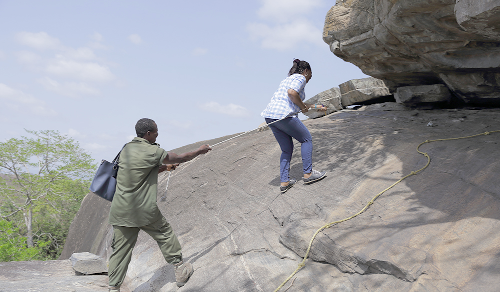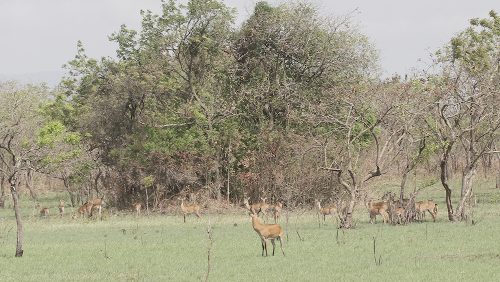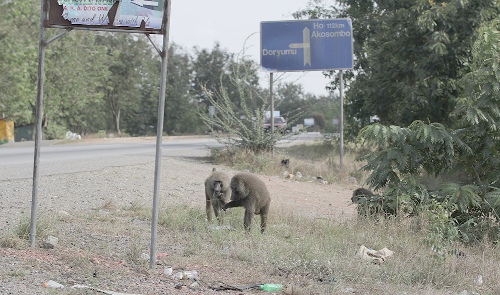
The Shai Hills Resource Reserve... an untapped national ‘gold mine’
Along the Accra-Akosombo highway, approximately 54 kilometres from Accra, lies a 51-square kilometre stretch of land full of baboons, green monkeys, antelopes and zebras. The area also has different species of plants, rocks and mountains. The beautiful scenery and clean air have a calming and refreshing effect on almost all visitors to the park.
Known as the Shai Hills Resource Reserve, it was established in 1971 to conserve wildlife and the cultural sites of the indigenous people who were driven away from the area by the colonial masters in 1892. The reason is not clear but the excuse they gave was that the people were engaged in human sacrifices and were troublesome.
Advertisement

These zebras were brought from the Mogo Hills to the reserve. Pictures: DOUGLAS ANANE-FRIMPONG
Despite its great potential as a tourist site in view of its easy accessibility, the reserve is fraught with numerous challenges.
Danger from speeding vehicles
Along the seven- kilometre stretch of road, I observe a line-up of baboons; some carrying their young ones, and often criss-crossing the road as they try to escape the wrath of speeding drivers. According to Mr Moses Anongura, who is the Park Manager, vehicles hitting the baboons along the route was a common occurrence. On hindsight, one is even tempted to question the originators for siting it so close to a major highway.
Human interference
Mr Anongura explained that some of the baboons are attracted to the roadside as a result of proximity and to enjoy edibles offered by passers-by. These include biscuits, bread, groundnuts and bananas. Over the years, the baboons had developed a taste for these edibles, motivating them to risk their lives at the roadside in expectation of more of these goodies. They will rather eat human food than feed from the baobab and nim trees and “monkey banana” in the bush. When they are unable to get the goodies, they attack passers-by they see holding stuff and rob them of their belongings. They ransack vehicles and vandalise motorcycles left unattended to in the area before owners are aware.
Activities of herdsmen and poachers
Apart from the danger on the road, herdsmen make life for the animals on the reserve uncomfortable as they set uncontrolled fire to the bush with the intention of getting fresh grass to grow to feed their cattle. Another challenge the park faces is the activities of poachers who will normally visit in the night and hunt for game in the reserve. Sometimes the game and wildlife officers are only able to tell that poachers had been at work the previous night as most of the animals hide, and they find one or two who had been injured by gunshots but were able to escape the poachers, lying down and gasping for breath. They are left to die because there is no facility to take care of sick or injured animals.
Low manpower
With a staff strength of 14, and with no proper equipment and means of transport, one of the game and wildlife officers, Mr Abraham Narh-Tetteh says he and his colleagues patrol the 51-square kilometre reserve on foot. Ideally, their strength should not be less than 28 wardens, to allow for both day and night patrols.
Visibility
The reserve also suffers from a lack of visibility, as no efforts are made to publicise its existence to potential tourists. Even at the entrance, there is no big signpost announcing the existence of the park and what it offers. I was surprised to know that apart from the baboons which attracted me to the reserve, there were other animals such as an ostrich, green monkeys and zebras. In spite of this, the reserve receives an average of 400 visitors on holidays while it records about 20-30 people on other days. Last year, the reserve recorded a total of 21,000 visitors, with 70 per cent of the figure being domestic tourists. The previous year recorded 15,000.
Poor accommodation facilities
The reserve has no proper facilities that are expected of a modern-day tourist resort. There is no in-house canteen for visitors to buy food and drinks and if one decided to pass the night in order to see more animals and the beautiful scenes, the seven-room guest house owned by the reserve is not in good shape.
Effect of stone quarries
The reserve is located near stone quarries and this has had a negative effect on the operations at the park. All the buildings have developed cracks as a result of the operations of these quarries in the area. In spite of complaints to the Environmental Protection Agency more than 20 years ago, no action has been taken, resulting in more quarry activities even closer to the reserve. Dust and booms from the blasting of rocks is a constant feature, scaring the animals on the park. Mr Anongura said the most dangerous of those activities “are the flying chippings which could be harmful to visitors and the animals.”

Mr Abraham Narh-Tetteh telling the Daily Graphic team about the reserve
The area is noted for quarrying and was the source of rocks and stones used for the construction of the Akosombo Dam and the Tema Harbour. The rail tracks which served this purpose are no more there.
Fencing and effect of rains
The fence around the park has been cut by intruders, making it even more impossible to control activities on the park. This makes the work of poachers easier. Also when it rains, the place is rendered impassable because of the clayey nature of the soil. To make the plight of the animals worse, the supply of water is a problem as the dugouts for animals often dry out in the dry season. Sometimes the members of staff have to go in search of water for the animals.

One of the baboons crossing the road and risking its life in search of food
In spite of the challenges, the potential of the reserve to contribute to the national kitty is not in doubt. The reserve seems to have so much potential for the generation of revenue if packaged properly and the necessary equipment and facilities provided. There is the need for some vehicles or motorbikes to help the game and wildlife officers patrol the reserve in order to reduce uncontrolled human intervention.
For starters, the authorities responsible for the park should consider signages to create awareness about the park and speed humps along the short stretch to reduce the killing of animals along that route.

The reserve has many antelopes
In the meantime, some public-spirited organisations could help out with desilting the dugouts in order to provide the much needed water for the animals and provide hand-held communication for wardens. In spite of the fact that the park needs a 28-member staff strength, the 14 currently there seem enthusiastic about their work as seen in Mr Narh-Tetteh, who took the writer around the park and knew every corner. It will, however, take more than enthusiasm in the form of resources, facilities and motivation of the staff to put the park in a proper stead to serve both Ghanaians and non-Ghanaian visitors and bring in the much-needed income/ revenue as well as generate the needed employment the country needs.

It is common to find the baboons along the road
There is definitely the need for some public education on the need for wildlife conservation. As Mr Narh-Tetteh said, visitors to the park on seeing the animals would sometimes exclaim” Anam nie”! connoting they see potential meat and not the beauty of wildlife as intended. Moving forward, I think there is the urgent need for some public-private partnership to provide the needed facilities such as restaurants/ canteen, proper accommodation facilities, a swimming pool and others, that will make it a whole entertainment and education package for visitors.
Writer’s E-mail: doreen. hammond @graphic.com. gh/[email protected]